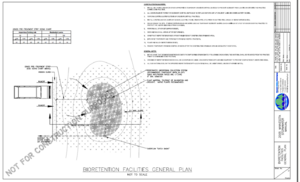
Difference between revisions of "Construction specifications for bioretention"
m |
m |
||
| Line 81: | Line 81: | ||
*3 to 5 percent organic matter by weight (ASTM D 2974 Method C) | *3 to 5 percent organic matter by weight (ASTM D 2974 Method C) | ||
Higher (12 percent) fines content should be reserved for areas where TN is the target pollutant. In areas where phosphorus is the target pollutant, lower (8 percent) fines should be used. | Higher (12 percent) fines content should be reserved for areas where TN is the target pollutant. In areas where phosphorus is the target pollutant, lower (8 percent) fines should be used. | ||
| − | + | {{:Design guidelines for soil characteristics - tree trenches and tree boxes#Bioretention Soil Mix D}} | |
| − | + | {{:Comparison of pros and cons of bioretention soil mixes}} | |
Revision as of 20:20, 9 January 2014
This page provides construction details, materials specifications and construction specifications for bioretention systems.
Contents
Construction details

CADD based details for bioretention are contained in the Computer-aided design and drafting (CAD/CADD) drawings section. The following details, with specifications, have been created for bioretention systems:
- Bioretention Facilities General Plan
- Bioretention Facilities Performance Types Cross-Sections
- Infiltration / Recharge Facility
- Filtration / Partial Recharge Facility
- Infiltration / Filtration / Recharge Facility
- Filtration Only Facility
Materials specifications
Soil medium / filter media content
Mix A: Water quality blend
A well blended, homogenous mixture of 55 to 65 percent construction sand: 10-20 percent top soil; and 25 to 35 percent organic leaf compost is necessary to provide a soil medium with a high infiltration/filtration capacity.
- Sand: Provide clean construction sand, free of deleterious materials. AASHTO M-6 or ASTM C-33 with grain size of 0.02 to 0.04 inches
- Top Soil: Sandy loam, loamy sand, or loam texture per USDA textural triangle with less than 5 percent clay content
- Organic Leaf Compost: (MnDOT Grade 2) 2 (see also the section on Using Compost as a Soil Amendment
Mix B: Enhanced filtration blend
A well-blended, homogenous mixture of 50 to 70 percent construction sand and 30 to 50 percent organic leaf compost is necessary to provide a soil medium with a higher infiltration/filtration capacity.
- Sand: Provide clean construction sand, free of deleterious materials. AASHTO M-6 or ASTM C-33 with grain size of 0.02 to 0.04 inches
- Organic Leaf Compost: Mn/DOT Grade 2
- Topsoil in the mix will help with some nutrient removal, especially nutrients, but extra care must be taken during construction to inspect the soils before installation and to avoid compaction.
Soil medium / filter media depth
Field experiments show that pollutant removal is accomplished within the top 30 inches of soil depth with minimal additional removal beyond that depth (Prince George’s County, 2002). Therefore, the recommended depth of the prepared soil is 30 inches. However, if large trees are preferred in the design, a soil depth of 48 to 52 inches should be utilized. The soil depth generally depends upon the root depth of the prescribed vegetation and content of underlying soils.
Gravel Filter Specifications - Underdrain gravel blanket shall be double washed stone, 1 to 1½ inches in size. Pea Gravel shall be washed, river-run, round diameter, ¼ - ½ inch in size.
Mulch Content and Depth - Fresh shredded bark mulch (Mn/DOT Type 6) should be used when possible to maximize nitrogen retention. If aged mulch is used, use the shredded type instead of the “chip” variety to minimize floating action. The mulch layer should not exceed 3 inch in depth. Too much mulch can restrict oxygen flow to roots. In addition, mulch should not be mounded around the base of plants since this encourages damage from pests and diseases.